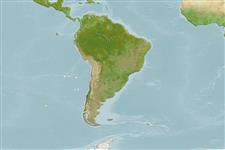Bivalvia |
Venerida |
Veneridae
Environment: milieu / climate zone / пределы глубины / distribution range
экология
; пределы глубины 0 - 20 m (ссылка 101272). Temperate, preferred 18°C (ссылка 107945); 16°S - 47°S, 110°W - 70°W
Southeast Pacific: Chile, Easter Island, and Peru. Subtropical to temperate.
Length at first maturity / Size / Weight / Возраст
половая зрелость: Lm ? range ? - ? cm Max length : 8.0 cm SHL самец/пол неопределен; (ссылка 101426)
Common shell length is between 5 to 7 cm (Ref. 101426). Subtidal, living just below the surface of sandy substrates. Also found intertidally in mud and gravel (Ref. 116664). Has high lethal temperature threshold, surviving El Niño events (Ref. 105334). In general, suspension feeding bivalves mainly depend on phytoplankton and detritus material for nutrition (Ref. 107088).
Life cycle and mating behavior
половая зрелость | размножение | нерест | Eggs | Fecundity | Larvae
Members of the class Bivalvia are mostly gonochoric, some are protandric hermaphrodites. Life cycle: Embryos develop into free-swimming trocophore larvae, succeeded by the bivalve veliger, resembling a miniature clam.
Основная ссылка
ссылки | координатор | соавторы
Urban, H.J. and B. Campos 1994 Population dynamics of the bivalves Gari solida, Semele solida and Protothaca thaca from a small bay in Chile at 36° S. Mar. Ecol. Prog. Ser. 115:93-102. (ссылка 75339)
Статус Красного Списка МСОП
(ссылка 130435: Version 2025-1)
Статус СИТЕС (ссылка 108899)
Not Evaluated
CMS (ссылка 116361)
Not Evaluated
Угроза для людей
Использование человеком
рыболовство: коммерческий
FAO - рыболовство: landings, Видовой профиль | FishSource | Sea Around Us
инструменты
дополнительная информация
Life cycleразмножениеполовая зрелостьFecundityнерестEggsРазвитие икрыLarvae PhysiologyOxygen consumption
Human RelatedStamps, coins, misc.
ресурсы в Интернет
Estimates based on models
устойчивость к внешним воздействиям
средний (среднего размера), минимальное время удвоения популяции 1.4-4.4 года (K=0.17-0.25).
Fishing Vulnerability
Low to moderate vulnerability (35 of 100).
Climate Vulnerability
High vulnerability (59 of 100).
Nutrients : Calcium = 149 [71, 228] mg/100g; Iron = 8.53 [1.95, 15.11] mg/100g; Protein = 9.88 [8.64, 11.12] %; Omega3 = 0.313 [0.202, 0.423] g/100g; Selenium = 61 [50, 72] μg/100g; VitaminA = 0 μg/100g; Zinc = 2.04 [0.56, 3.51] mg/100g (wet weight); based on
nutrient studies.
